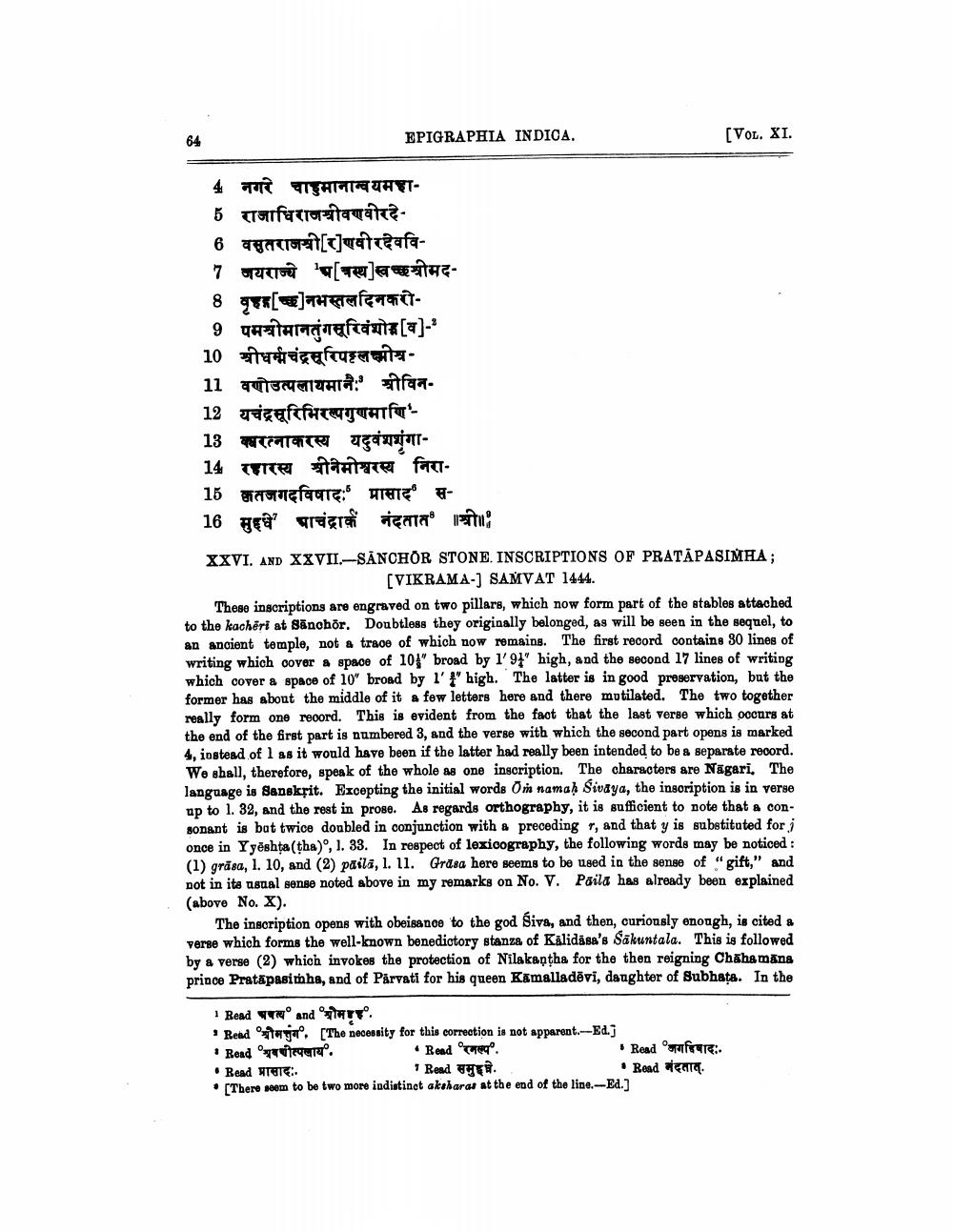________________
EPIGRAPHIA INDICA.
[VoL. XI.
4 नगरे चाहुमानान्वयमहा6 राजाधिराजश्रीवणवीरदे6 वसुतराजश्री[रणवीरदेववि7 जयराज्ये 'प[वस्थ] स्वच्छश्रीमद8 वृहा[छ]नभस्तलदिनकरो9 पमश्रीमानतुंगसूरिवंशोड[व]-' 10 श्रीधर्मचंद्रसूरिपट्टलक्ष्मीत्र11 वणोउत्पलायमानः' श्रीविन12 यचंद्रसूरिभिरल्पगुणमाणि'13 क्वरत्नाकरस्य यदुवंशशृंगा14 रहारस्य श्रीनमीश्वरस्य निरा16 वतजगदविषादः प्रासाद स16 मुद्दधे पाचंद्रार्क नंदतात श्री॥
XXVI. AND XXVII.-SANCHOR STONE. INSCRIPTIONS OF PRATĀPASIMHA ;
[VIKRAMA-] SAMVAT 1444. These inscriptions are engraved on two pillars, which now form part of the stables attached to the kachéri at sānohor. Doubtless they originally belonged, as will be seen in the sequel, to an ancient temple, not a trace of which now remains. The first record contains 30 lines of writing which cover a space of 101" broad by 1'97' high, and the second 17 lines of writing which cover & space of 10' broad by l''high. The latter is in good preservation, but the former has about the middle of it a few letters here and there mutilated. The two together really form one reoord. This is evident from the fact that the last verse which occurs at the end of the first part is numbered 3, and the verse with which the second part opens is marked 4, instead of l as it would have been if the latter had really been intended to be a separate record. We shall, therefore, speak of the whole as one inscription. The characters are Nagari, The language is Sanskrit. Excepting the initial words om namah Sivaya, the insoription is in verse up to 1. 32, and the rest in prose. As regards orthography, it is sufficient to note that a consonant is bat twice doubled in conjunction with a preceding , and that y is substituted for i once in Yyeshta(tha),1. 33. In respect of lexicography, the following words may be noticed : (1) grāsa, 1. 10, and (2) paila, 1. 11. Grasa here seems to be used in the sense of "gift," and not in its usual sense noted above in my remarks on No. V. Paila has already been explained (above No.x).
The inscription opens with obeisance to the god Siva, and then, curiously enough, is cited a verse which forms the well-known benedictory stanza of Kalidasa's Sakuntala. This is followed by a verse (2) which invokes the protection of Nilakantha for the then reigning Chahamana prince Pratapasithhe, and of Parvati for his queen Kamalladēvi, daughter of Subhata. In the
1 Read अचव and श्रीमाई. - Read श्रीमत्तुंग', [The necessity for this correction is not apparent.-Ed.] - Read अवधीत्पलाय. • Read रनल्प.
• Read जगहिषादः• Read प्रासादः. I Rend समुहले.
• Read नंदतात. • There seem to be two more indistinct akaharas at the end of the line.-Ed.]




